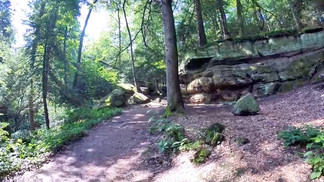What I Wish I Knew Before Visiting Cuyahoga Valley National Park-10 Facts
- CampBrood
- Sep 21, 2024
- 7 min read
Did you know the Cuyahoga River was so polluted that it caught fire and was the catalyst for the creation of the United States Environmental Protection Agency? Come journey with us on some of Cuyahoga Valley National Park’s best trails as we discuss this and 9 more facts you need to know about Ohio’s National Park. Let’s Get Started by answering a few questions while riding the towpath trail. To watch the video version of this blog click here or continue reading below.
When asking why an area is a National Park many people ask
What Historical Significance does Cuyahoga Valley National Park protect?
The Ohio & Erie Canal, flowing south to north next to the towpath trail and through the heart of Cuyahoga Valley National Park, played a pivotal role in the 19th-century development of the region. Constructed between 1825 and 1832, the canal connected Lake Erie to the Ohio River, greatly enhancing transportation and commerce. This waterway facilitated the movement of goods and people, contributing to the economic growth of Ohio and the Midwest. Maybe more importantly the canal provided an easier route for goods and information to be transported from middle Ohio back east. The canal's remnants, including locks and the towpath, are preserved within the park, offering visitors a glimpse into the past and the region's industrial heritage.
We’ll talk more about the history of Cuyahoga Valley later but the other reason National Parks are created is to protect the environment. so
What Types of Biodiversity can Visitors Expect to Find in the Park?
Cuyahoga Valley National Park is a haven for biodiversity, boasting a wide variety of plant and animal species. Visitors can encounter over 250 bird species, 70 fish species, and numerous mammals, reptiles, and amphibians. The park's diverse habitats, including forests, wetlands, and grasslands, support a vibrant array of wildlife. Seasonal changes bring different flora and fauna to the forefront, making each visit a unique experience for nature enthusiasts. But the park is also protecting endangered species including the Indiana Bat, Spotted Turtle and Freshwater Mussels. One special place in Cuyahoga is here at the Beaver Marsh. The Marsh used to be a junkyard, but today is a refuge for migrating birds moving in the Spring and Fall. In the Marsh you will find frogs, turtles, and maybe mammals like beaver enjoying the water. There are over 1,500 wetlands in the park and the Beaver Marsh is 70 acres of the complex ecosystem supporting life for many.
If you are reading this post outside of Ohio you may be asking
Where is Cuyahoga Valley National Park located?
Cuyahoga Valley National Park is located in northeastern Ohio, nestled between the cities of Cleveland and Akron. Its central location makes it easily accessible for visitors from the surrounding urban areas, providing a natural escape amid a densely populated region. The towpath trail that we are riding today actually travels through the park and connects Akron to Cleveland. So, the trail is a great way for people spending time in either city to hop on their bikes and escape the City and autos on this recreational trail . At its northernmost point the park is only 10 miles South of Lake Eerie and the broader great lakes waterways and shipping channels which is vital to one of the most important movements in American history coming up later.
We’ll get back to our list with some bootlegger history in a moment but,
Are you enjoying this post as you plan for your trip to Cuyahoga? Join our blog above to get more insights on other national parks we've been to. Ok back to the list while we hike the Ledges trail and
What Occurred in Cuyahoga Valley During Prohibition?
The park's remote areas were once used for illegal activities in the 1920s during Prohibition, including moonshining. The rugged terrain provided hiding spots for distilleries away from the city but close enough for buyers and sellers to get together in speakeasies. These were legitimate businesses selling alcohol on the side or hidden places where people offered booze for sale. As we hike the ledges trail you can probably see where some of these could have been hidden away from law enforcement and snitches. Maybe the ice cave located next to the trail housed a still.
Some have asked,
Is There a City Inside Cuyahoga Valley National Park?
The park contains a few locations that were small villages before the area was preserved. The most popular example back on the towpath trail is Boston Mill. Here you can find Cuyahoga Valley National Parks visitors center housed in the 1836 Boston Company Store. Boston Mill included a boat-yard, warehouse, water powered mill and a hotel. Just south of Boston you’ll discover Peninsula. Here you will find businesses still in existence but you will also be able to see Lock 29 which is a well preserved lock you can walk into and discover how the boats were raised and lowered along the canal. The parking lot offers great views of the river and access to the towpath trail. The demise of the canal system was in part determined by the railroad. Through both of these locations you can hop a ride on the Cuyahoga scenic railroad and tour the park in comfort. More about the River fire is next but
Every good national park post needs a dad joke. While hiking in Cuyahoga my son suddenly laughed. I asked him what was so funny and he said he couldn’t tell me because it was an Inside Joke.
Here are dad joke books for great gifts: Dad Jokes Around the Campfire: https://amzn.to/3JinFJ2 600 Funniest Dad Jokes: https://amzn.to/3EPGv7D To view any product mentioned by us in our videos and blog, click this link: https://www.amazon.com/shop/campbrood As an Amazon Associate, we earn a commission from qualifying purchases.
Ok, back to the list and let’s answer the question,
What is the Significance of the Cuyahoga River Fire of 1969 in Environmental History?
The infamous 1969 fire on the Cuyahoga River, the route of the Ohio and Erie canal, is a landmark event in environmental history. The river, heavily polluted by industrial waste, was a symbol of pride and economic activity. But it caught fire, many times in the 1900s, drawing national attention to the issue of water pollution in the late 1960s. This event, where the river surface spontaneously combusted, spurred significant environmental reforms, including the creation of the Environmental Protection Agency (EPA) by President Richard Nixon and the passage of the Clean Water Act. Exploring Cuyahoga Valley today you would never guess it happened but the fire's legacy underscores the importance of environmental protection and the progress made in restoring the health of the Cuyahoga River and other water bodies.
Coming up next we’ll discuss the significance of the region before the Civil War but while enjoying Brandywine Falls it's good to know
How was the Park Established?
In the year 2000, President Bill Clinton signed legislation by Congress for Cuyahoga Valley to be designated as a National Park. But the process started almost a century earlier. In the 1920s various local organizations started to understand the significance of the Cuyahoga River and the Valley it helped create. One example is the Stanford family’s decision to donate the Virginia Kendall Unit which includes the Ledges trail we are hiking right now in the 1930s. Other donations and purchases occurred where in 1974 the land was designated the Cuyahoga Valley National Recreation Area formally transferring control from the state and local governments to the care and protection of the United States. 26 years later after much lobbying and advocacy the recreation area became the 56th National Park.
Why was Cuyahoga Valley important to the Underground Railroad?
The park area played a significant role in the Underground Railroad. Cuyahoga Valley's proximity to Lake Erie and its position along the Ohio & Erie Canal made it a crucial corridor for freedom seekers traveling northward. The dense forests, secluded valleys, and sympathetic communities provided cover and support for escaping slaves. But, many homes, families, and farms in Cuyahoga Valley served as safe houses, providing shelter, food, and assistance to freedom seekers on their journey. The trails and waterways made it an accommodating passage to Lake Erie where larger networks helped transport to other states and even Canada. Today, several historic sites in Cuyahoga Valley preserve the memory of the Underground Railroad, including the John Brown House in Peninsula, which was owned by abolitionist John Brown's family.
Considering the routes that were taken leads us to this question we’ll answer as we head back to the Ledges.
How big is Cuyahoga Valley National Park?
The city of Cleveland, Ohio, covers an area of approximately 82.5 square miles.. This includes both land and water areas within the city's boundaries. For a further perspective, Cuyahoga Valley National Park's 33,000 acres (or about 51.6 square miles) makes it roughly two-thirds the size of Cleveland in terms of land area. But it is long and narrow being about 17 miles from north to south and about 7 miles at its widest point east and west. But in at least one location along Alexander road the park is less than 1 mile wide.
If you are planning your first trip you may want to know
What Recreational Activities are Available for Visitors in Cuyahoga Valley National Park?
The park offers an extensive range of recreational activities to cater to all interests. Visitors can hike over 125 miles of trails, including the popular Towpath Trail, which follows the historic route of the Ohio & Erie Canal. Cycling, bird watching, fishing, horseback riding, and kayaking are also popular activities. The park's diverse terrain and well-maintained trails provide opportunities for both leisurely walks and challenging hikes, ensuring an enjoyable experience for all levels of outdoor enthusiasts.
Here are some examples of what we took exploring Cuyahoga Valley National Park
Teton Sports Hydration Pack Video Review: https://youtu.be/KEBrYwp8RQk
Amazon Link: 2021 model https://amzn.to/3SnKcGR
2022 model https://amzn.to/3vIogMZ
Camelbak Mini M.U.L.E hydration backpack Video Review for younger hikers: https://youtu.be/WbRgZr6C20g
Amazon Link: https://amzn.to/3Zpj91p
Merrell Moab II Men's Hiking Shoes: https://amzn.to/3Ardw8k
The First Aid Kit we carry: https://amzn.to/3Lcvu2h
Trekking Poles: https://amzn.to/3DHj54L
Tactical Flashlights: https://amzn.to/3QLY25T
Compass: https://amzn.to/3GahGU5
To learn more about Cuyahoga Valley and continue planning your trip read this post next.





















































